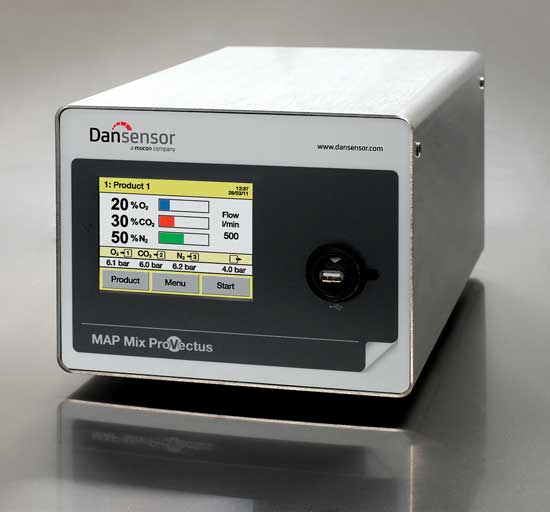Modified Atmosphere Packaging Expands
PACKAGING
Motivation to use modified atmosphere packaging (MAP) is increasing, and industry insiders project MAP to reach 468 billion packages by 2019. As food companies use fewer preservatives and trans fats, and storage temperatures continue to be costly to control, MAP offers a solution. The types of barriers for MAP vary from breathable to essentially impermeable packaging. There is a need for more research that focuses on decreasing the microbial risk associated with MAP and increasing its sustainability. Thanks to extensive research on deteriorative mechanisms in foods, MAP is being used to extend the freshness of many products, including produce, meats, baked goods, and snack foods.
Using MAP to Extend Shelf Life of Produce
Although the biochemical and physiological basis for the deterioration of fruits and vegetables varies, respiration rates and microbial growth largely dictate the minimum carbon dioxide and oxygen tolerances of fruits and vegetables within MAP. Respiration rates vary as a function of factors such as product surface area, agricultural variety, growing season, and environment. These rate ranges have long been established for certain vegetables and fruits: In general, reduced oxygen levels retard ripening, but some vegetables cannot tolerate low oxygen levels. For example, oxygen levels lower than 3% are not tolerated well by avocados, tomatoes, and cucumber while oxygen levels below 1% are not tolerated well by apples, broccoli, and mushrooms. For carbon dioxide levels greater than 1%, the ripening of some produce slows, extending its shelf life, and in general, the efficacy of carbon dioxide in delaying the ripening of fruits and vegetables increases as temperatures rise. This is important since many fruits and vegetables are exposed to higher than desired temperatures during transport. Although levels of carbon dioxide greater than 10% reduce mold growth, some fruits and vegetables—in particular, apples, tomatoes, and mangoes—do not tolerate carbon dioxide levels higher than 10%. Inappropriate levels of carbon dioxide, oxygen, and ethylene are apparent when the surface of fruit is pitted, when lettuce turns brown, and in enzymatic browning reactions.
Vincente Peris S.A., Valencia, Spain (vicenteperis.com), uses MAP to enable a 10-day shelf life for halves of melon, pumpkin, and pineapple. Packaging produce in an anaerobic environment can result in the growth of harmful pathogens that thrive in anaerobic conditions and the production of volatiles. Many polymers are excellent options for packaging produce, but they are often not as permeable as needed for optimal shelf life. For most lettuces, oxygen transmission rates between 770 cc/m2 per 24 hr and 3,000 cc/m2 per 24 hr are needed. Although solutions such as anti-blocking agents to increase the porosity of films have been employed, they reduce package clarity.
Microperforations ranging in diameter from 40 µm to 150 µm are now common. Oxygen permeability is managed by the size, amount, and design of the microperforations on packages. The rate of exchange for oxygen and carbon dioxide is equal, and equilibrium is often achieved in two or three days in green beans, broccoli, cherries, cut melons and pineapple, and lettuce. Microperforations also enable the rapid influx of gas mixtures that can extend shelf life at different stages of maturity and allow gas that kills bacteria to escape before consumers purchase such packages. BreatheWay, Guadalupe, Calif. (breatheway.com), has a membrane containing a patch composed of side-chain crystallizable polymers to control the flow of gas as temperature varies. This allows for permeable packaging at higher temperatures, lower permeability at lower temperatures, and the control of ethylene gas, which modulates the ripening of products such as bananas. And films made from the by-products of agriculture (i.e., bio-derived packaging) hold much promise because they inherently possess high oxygen permeability. Recent research efforts at INRA – Montpellier Center and the Fraunhofer Institute for Process Engineering and Packaging IVV have also generated commercially viable bio-derived packaging for produce.
Inhibiting Pathogen Growth in Meats with MAP
Concerns over bacterial growth govern most packaging protocols to extend shelf life in meats and seafood. Non-commercially sterilized meat and seafood are prone to growth of Clostridium botulinum, Escherichia coli O157:H7, Salmonella, Listeria, Vibrio, and other pathogens. A two-phase system of frozen distribution and refrigeration at retail extends shelf life and enables consumers to see fresh meat and seafood at retail: Meats are shipped frozen at low oxygen levels and then displayed in retail packaging that has a high oxygen transmission rate to facilitate redness and the appearance of freshness. For seafood, C. botulinum is of high concern, so anaerobic and aerobic packaging are controlled. If storage temperatures are inappropriate, the risk of C. botulinum increases because the pathogen can grow at 38°F. According to the U.S. Food and Drug Administration, an anaerobic environment must be used in conjunction with time-temperature indicators (TTIs) and temperatures cannot exceed 38°F. “The potential for botulism keeps the volume of MAP, unpasteurized, refrigerated fish far lower than frozen. Industry shies away from TTIs, but for now, TTIs are the principal hurdle to enable the fresh market,” says Barbara Blakistone, vice president of aquatic food products, IEH Laboratories and Consulting Group. Alternatively, an aerobic environment within a package must be guaranteed via the use of high (10,000 cc/m2 per 24 hr) oxygen transmission rate barriers.
 Innovation in MAP for seafood is moving fast. Alfa Gamma Seafood Group, Miami, Fla. (alfaseafood.com), uses packaging that maintains a low temperature coupled with carbon monoxide to extend the shelf life of its refrigerated fish. A patented technology for shipping ocean freight by BluWrap, San Francisco, Calif. (bluwrap.com), “significantly lowers carbon emissions, replaces polystyrene with recyclable materials, and eliminates the need for ice in the seafood supply chain,” explains Alex Oliviera, vice president of scientific affairs, BluWrap.
Innovation in MAP for seafood is moving fast. Alfa Gamma Seafood Group, Miami, Fla. (alfaseafood.com), uses packaging that maintains a low temperature coupled with carbon monoxide to extend the shelf life of its refrigerated fish. A patented technology for shipping ocean freight by BluWrap, San Francisco, Calif. (bluwrap.com), “significantly lowers carbon emissions, replaces polystyrene with recyclable materials, and eliminates the need for ice in the seafood supply chain,” explains Alex Oliviera, vice president of scientific affairs, BluWrap.
“In addition,” she continues, “usage of water for thawing fish is eliminated and food waste is reduced. The technology consistently delivers 22 to 42 days of distribution shelf life and 12 to 16 days of retail shelf life when quality seafood is used.”
Stalling Oxidation in Snack Foods
The trend toward reformulating foods to contain more unsaturated fats than saturated fats has increased the propensity for many foods to undergo lipid oxidation. Commonly used for nuts and chips, MAP with low oxygen transmission rates is now becoming more prevalent for other snack-food packaging. Although butylated hydroxytoluene and butylated hydroxyanisole have commonly been used as antioxidants within packaging, they suppress oxidation after it has started. Lower levels of oxygen are needed to stop oxidation and increase the shelf life of reformulated products. Superior oxygen barriers can be achieved with metalized film, high-barrier multilayer structures, or rigid structures. A metallized structure such as bMET, by Bemis Company Inc., Neenah, Wis. (bemis.com), offers a barrier to reduce light-induced oxidation and a barrier for oxygen. This package structure and others with a layer of ethylene vinyl alcohol (EVOH) are not recyclable. Recyclable/reusable polyethylene terephthalate (PET) canisters that incorporate low concentrations of EVOH offer the same barrier properties as alternative flexible non-recyclable structures.
Oxygen scavenging sachets that sequester oxygen are available from Clariant, Charlotte, N.C. (clariant.com); Multisorb Technologies, Buffalo, N.Y. (multisorb.com); and Mitsubishi Gas Chemical America, New York, N.Y. (ageless.mgc-a.com). Other packaging solutions that contain oxygen scavengers within the structure are Active Barrier by Invista, Wichita, Kan. (invista.com); valOP by Valspar Corp., Minneapolis, Minn. (valsparpackaging.com); ShelfplusO2 by Albis Ibérica, Hamburg, Germany (albis.com/en/products-solutions); and Oxyguard by Toyo Seikan Co., Tokyo, Japan (toyo-seikan.co.jp/e/). Oxygen barriers within closures include the ColorMatrix HyGuard by PolyOne Corp., Avon Lake, Ohio (polyone.com/products/brands/colormatrix). There is also research on developing packages that incorporate palladium, sodium ascorbate, and plant-derived gallic acid within polymers.
Reducing Microbial Growth in Other Products
Certain cheeses, preservative-free and gluten-free breads, and other products require MAP so that they remain free of deteriorative molds. When carbon dioxide is absorbed in the liquid phase of products, their pH drops, and their volume of headspace decreases. For cheese, absorption of carbon dioxide after the packaging operation results in pulling packaging to conform to the shape of the cheese. “Chunk and slice films for cheese are evolving from traditional three-layer laminations with ethylene vinyl acetate extrusion coated sealants to two-layer structures with extrusion or adhesive laminated sealants,” says Myron Geiser, senior director of R&D, TC Transcontin-ental Packaging, Montreal, Canada (tctranscontinental.com). For bakery products that will squish with too much pressure, carbon dioxide levels less than 75% with the remainder nitrogen are more common. This reduces mold growth since carbon dioxide absorbs into the product’s open-cell structure and removes the oxygen it needs to grow. High-barrier multilayer packaging (often with oxygen scavengers) composed of EVOH or thick-gauge PET with secure seals coupled with frozen or refrigerated distribution dominate MAP for cheese and preservative-free and gluten-free baked goods.
 Changing the MAP Industry
Changing the MAP Industry
Measuring volatile and deteriorative gases is evolving with portable high attenuation instruments becoming more common. Integrated systems that monitor oxygen levels when packages are filled are critical to food safety and quality programs. The gas mixture entering the packaging line can be continuously optimized. Oxygen analyzers such as MAPCheck3 by Dansensor, Minneapolis, Minn. (mocon.com), integrates with a ProVectus gas-mixing system to ensure that the gas mix is appropriate. OxySense, Dallas, Texas (oxysense.com) also offers integration capability.
As research in MAP continues to progress, packaging solutions that address the microbial risk and sustainability are needed. Research underway includes the development of bio-switches that activate in the presence of bacteria, encapsulation of antimicrobial plant extracts, the development of tolerances for toxin production and permeable packaging, and the development of antimicrobial biofilms. A new collaboration between DuPont Teijin Films, Chester, Va. (usa.dupontteijinfilms.com), and Virginia Polytechnic Institute and State University’s food science department will help fuel MAP research and development.
 Claire Koelsch Sand, PhD, Contributing Editor
Claire Koelsch Sand, PhD, Contributing Editor
President, Packaging Technology and Research
Adjunct Professor, Michigan State Univ.
[email protected]
